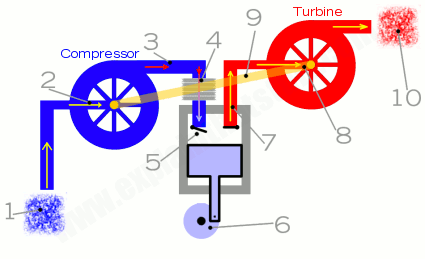How A Turbocharger Works
The basic idea is that the exhaust drives the turbine (the red fan), which is directly connected to (and powers) the compressor (the blue fan), which rams air into the engine. For simplicity, we’re showing only one cylinder. Here then, in summary, is how the whole thing works:
1. Cool air enters the engine’s air intake and heads toward the compressor.
2. The compressor fan helps to suck air in.
3. The compressor squeezes and heats up the incoming air and blows it out again.
4. Hot, compressed air from the compressor passes through the heat exchanger, which cools it down.
5. Cooled, compressed air enters the cylinder’s air intake. The extra oxygen helps to burn fuel in the cylinder at a faster rate.
6. Since the cylinder burns more fuel, it produces energy more quickly and can send more power to the wheels via the piston, shafts, and gears.
7. Waste gas from the cylinder exits through the exhaust outlet.
8. The hot exhaust gases blowing past the turbine fan make it rotate at high speed.
9. The spinning turbine is mounted on the same shaft as the compressor (shown here as a pale orange line). So, as the turbine spins, the compressor spins too.
10. The exhaust gas leaves the car, wasting less energy than it would otherwise.







